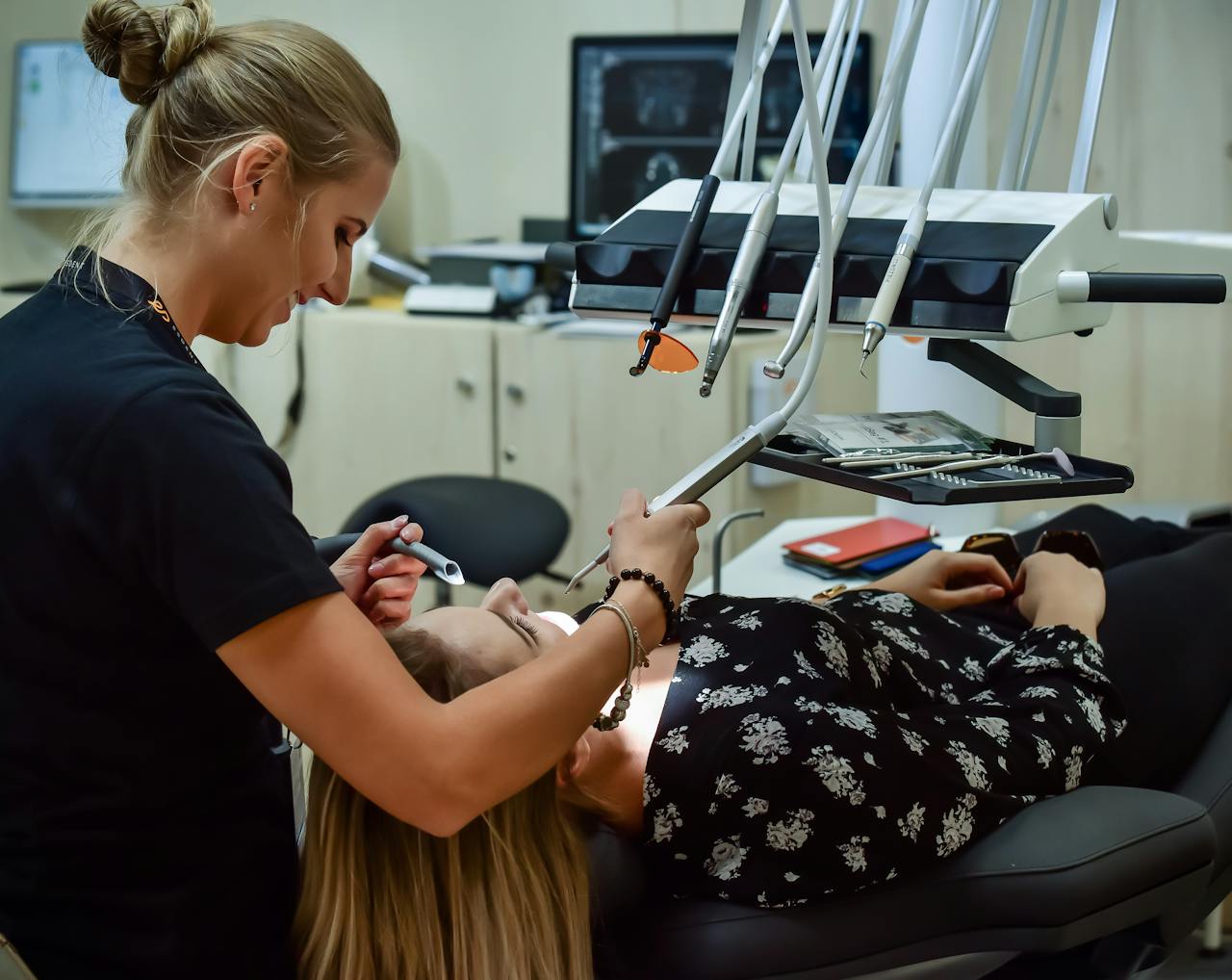Designing Outbound Call Flows That Mirror Your Front Desk’s Rules

Your dental practice's front desk follows specific protocols for patient interactions, and your outbound call flows should mirror these same professional standards. When patients receive automated calls for appointment reminders or follow-ups, they expect the same level of care and attention they experience in person.
Designing outbound call flows that match your front desk procedures ensures consistent patient experiences while reducing missed appointments and improving practice efficiency. Most dental offices lose significant revenue from no-shows, but automated outbound calls can boost outreach and maintain patient engagement between visits.
The key lies in creating workflows that feel personal rather than robotic, comply with healthcare regulations, and integrate seamlessly with your existing practice management systems. This approach transforms routine communication into a competitive advantage that strengthens patient relationships while protecting your bottom line.
Key Takeaways
- Automated call flows should match your front desk's tone and procedures to maintain consistent patient experiences
- Properly designed outbound workflows can significantly reduce appointment no-shows and increase practice revenue
- HIPAA-compliant automation tools help dental practices scale patient communication without compromising security or quality
Best Practices For Designing Outbound Call Flows
Successful outbound call flows require strategic planning that aligns with your dental practice's specific operational needs. The key lies in creating logical routing systems, establishing custom rules that match your front desk procedures, and implementing comprehensive response handling protocols.
Outbound Call Flow Logic For Dental Clinics
Dental practices need outbound call strategies that prioritize patient care while maintaining efficiency. The call flow should begin with patient identification and appointment verification within the first 30 seconds.
Priority-Based Call Routing:
- Urgent appointments: Emergency patients, pain management cases
- Standard follow-ups: Routine cleanings, check-ups
- Administrative calls: Insurance verification, payment reminders
Call duration should vary based on call type. Emergency callbacks require immediate connection, while routine appointment confirmations can utilize shorter interaction windows.
The system should route calls based on patient history and appointment complexity. New patients need longer call durations for information gathering, while established patients require quick confirmation processes.
Custom Rules That Reflect Front Desk Processes
Outbound calling systems must mirror your front desk's established protocols. Staff training materials and current phone scripts provide the foundation for automated call flow design.
Essential Custom Rules:
- Time-based restrictions: No calls before 8 AM or after 6 PM
- Patient preference tracking: Preferred contact methods and times
- Appointment type considerations: Different approaches for cleanings vs. procedures
The call routing logic should match how your front desk staff currently handles different patient types. If your team typically calls procedure patients three days ahead but cleaning patients one day ahead, the automated system needs identical timing rules.
Documentation of current processes helps identify which steps can be automated and which require human intervention. This ensures customer experience remains consistent across all touchpoints.
Voicemail, SMS, And Response Handling Strategies
Modern dental practices need multi-channel response strategies that adapt to patient preferences. Outbound call best practices emphasize the importance of having clear protocols for each communication method.
Response Handling Protocol:
- Live answer: Direct connection to appropriate staff member
- Voicemail: Automated message with callback number and urgency level
- No answer: Automatic SMS follow-up within 15 minutes
SMS messages should be concise and include essential appointment details. Voicemail scripts need to be professional yet warm, reflecting your practice's personality.
The system should track response patterns for each patient. Some patients consistently answer calls, while others prefer text communication. This data helps optimize future outbound calls and improves overall patient engagement rates.
Response timing matters significantly in dental practices. Same-day appointment confirmations require immediate follow-up if the initial call fails, while routine reminders can have longer response windows.
Improving Patient Engagement With Automated Workflows
Automated outbound calls can reduce no-shows by up to 30% while helping dental practices reactivate inactive patients through targeted campaigns. These systems track specific metrics like response rates and conversion rates to measure campaign effectiveness.
No-Show Prevention Using Automated Calls
Automated reminder calls significantly reduce missed appointments in dental practices. These systems can make multiple contact attempts at scheduled intervals before appointments.
The most effective approach uses a three-touch sequence. The first call goes out 48 hours before the appointment. A second reminder follows 24 hours prior. The final confirmation call happens 2-4 hours before the scheduled time.
Key timing strategies include:
- Morning calls (9-11 AM) show higher answer rates
- Avoid calling during lunch hours (12-2 PM)
- Evening calls (5-7 PM) work well for working patients
Practices that implement automated call systems see reduced call volume for their front desk staff. Staff can focus on patient care instead of making dozens of reminder calls daily.
The system should offer appointment confirmation, rescheduling, or cancellation options. Patients who cannot confirm get flagged for manual follow-up by front desk staff.
Reactivate Dormant Patients With Call Campaigns
Automated campaigns can bring back patients who haven't visited in 6-18 months. These targeted outreach efforts often yield conversion rates between 8-15% for dental practices.
The campaign should segment patients based on their last visit type. Patients due for cleanings receive different messaging than those who missed follow-up treatment appointments.
Effective reactivation messages focus on:
- Health benefits of regular dental care
- Special offers for returning patients
- New services or technology available
- Convenient scheduling options
Campaigns work best when they include multiple touchpoints over 2-3 weeks. The first call introduces the offer. Follow-up calls target patients who didn't respond initially.
Practices should track which patients schedule appointments versus those who request removal from call lists. This data helps refine future campaign targeting and messaging.
Response Rates Metrics In Dental Patient Outreach
Measuring campaign performance helps dental practices optimize their automated call strategies. Key metrics include answer rates, callback requests, and actual appointment bookings.
Primary metrics to track:
Metric Good Performance Needs Improvement
Answer Rate 35-50% Below 25%
Conversion Rate 8-15% Below 5%
No-Show Reduction 20-30% Below 10%
Answer rates vary by patient demographics and call timing. Younger patients often prefer text notifications over voice calls. Older patients typically respond better to personal phone calls.
The optimization of call flows in healthcare centers requires tracking both successful connections and patient actions taken after calls.
Conversion rate measures how many contacted patients actually schedule appointments. This metric directly impacts practice revenue and helps justify automation costs.
Follow-up calls to non-responders can improve overall campaign conversion rates. However, practices must balance persistence with patient privacy preferences to maintain positive relationships.
Reducing Revenue Losses From Missed Appointments
Dental practices face significant financial losses when appointments go unfilled or patients miss scheduled visits. Missed calls cost dental offices over $150,000 yearly, while no-shows cost $150-$200 per missed appointment.
Missed Calls And Cost To Dental Practices
Dental offices miss approximately 30% to 35% of inbound calls during busy periods. Each unanswered call represents a potential appointment, insurance inquiry, or emergency consultation.
The financial impact compounds quickly. Smaller dental practices lose nearly $9,800 per month from missed calls alone. Larger practices face losses exceeding $150,000 annually.
Key Revenue Loss Factors:
- 85% of callers don't call back after reaching voicemail
- 75-80% of patients don't leave voicemail messages
- Lost emergency appointments during after-hours periods
- Competitor advantage when patients call multiple offices
Front desk staff spend additional time calling patients back and rescheduling appointments. This creates a cycle where missed calls generate more administrative work, reducing overall practice efficiency.
Contact centers specifically designed for dental practices can capture these missed opportunities by providing consistent call coverage during peak hours.
Reducing No-Shows With Automated Scheduling
Automated reminder systems significantly reduce patient no-shows through multiple touchpoints. Text message reminders achieve 95% open rates compared to lower email engagement rates.
Outbound call centers can implement systematic reminder campaigns:
Reminder Timeline Method Content
48-72 hours before Phone call Appointment confirmation
24 hours before Text message Time and preparation instructions
2 hours before Automated call Final reminder with cancellation option
Automated systems integrate with practice management software to update appointments in real-time. When patients reschedule during reminder calls, the system immediately opens those slots for other patients.
Call center solutions with advanced scheduling systems help practices maintain full schedules by quickly filling cancelled appointments through waitlist management.
Practices using automated recall systems report fewer missed appointments and improved revenue stability.
Capturing After-Hours And Overflow Calls
After-hours calls represent significant revenue opportunities that traditional voicemail systems fail to capture. Patients often call outside business hours for emergency appointments, scheduling changes, or urgent questions.
Outbound call center solutions provide 24/7 coverage without requiring additional staff costs. These systems handle appointment scheduling, insurance verification, and basic patient inquiries during evenings, weekends, and holidays.
After-Hours Call Benefits:
- Emergency appointment scheduling for urgent dental issues
- Insurance verification completed before office hours
- Appointment confirmations for next-day visits
- Prescription refill requests processed overnight
Overflow call management ensures no calls go unanswered during busy periods. When multiple patients call simultaneously, the system queues calls and provides estimated wait times rather than sending callers to voicemail.
Practices report up to 35% reduction in missed calls when implementing comprehensive after-hours coverage. This translates directly to increased appointment bookings and improved patient satisfaction scores.
Customizing Scheduling Flows For Dental Practices
Dental practices need scheduling flows that handle multiple treatment types, provider availability, and prevent costly booking conflicts. Modern systems must integrate with existing practice management software while supporting multi-language capabilities for diverse patient populations.
Real-Time Calendar And Practice-Management Integrations
Real-time calendar synchronization prevents scheduling conflicts by instantly updating appointment availability across all booking channels. When a patient books a cleaning through an automated system, the appointment immediately appears in the practice management software.
Most dental practices use existing CRM and practice management systems that store patient records, treatment histories, and insurance information. Customized scheduling models must connect directly to these databases to access patient preferences and treatment requirements.
Integration features include:
- Two-way calendar sync with popular dental software
- Patient record access for appointment history
- Insurance verification during booking
- Treatment-specific time blocks based on procedure codes
The scheduling system should automatically adjust available time slots based on the type of treatment requested. A routine cleaning requires 45 minutes, while a crown preparation needs 90 minutes.
Staff can override automated bookings when necessary. Emergency appointments or complex cases may require manual scheduling adjustments that the system immediately reflects across all platforms.
Multi-Provider And Multi-Language Schedules
Dental practices with multiple providers need scheduling flows that match patients with the right dentist or hygienist. Each provider has different specialties, availability, and treatment preferences that affect appointment booking.
The system should route patients based on:
- Treatment type requirements (general dentistry vs. orthodontics)
- Provider availability and schedule preferences
- Patient history with specific providers
- Insurance network participation by provider
Multi-language support becomes essential for practices serving diverse communities. Patients should complete scheduling in their preferred language without staff intervention.
Common language requirements:
Language Typical Use Cases
Spanish General appointments, insurance questions
Mandarin Specialty consultations, treatment explanations
Arabic Emergency scheduling, payment discussions
The scheduling flow automatically detects patient language preferences from previous interactions or allows selection at the beginning of the call. All appointment confirmations and reminders continue in the chosen language.
Provider-specific rules prevent inappropriate bookings. Dental practice scheduling optimization requires systems that understand each dentist's capabilities and time requirements.
Ensuring Double-Booking Prevention
Double-booking prevention requires real-time database checks before confirming any appointment. The system must verify chair availability, provider schedule, and equipment requirements simultaneously.
Multiple booking channels create double-booking risks. Patients may call while staff manually schedule appointments, or two automated systems might access the calendar simultaneously.
Prevention mechanisms include:
- Database locking during appointment creation
- Immediate availability updates across all channels
- Buffer time insertion between complex procedures
- Equipment conflict checking for specialized treatments
The system should also prevent inappropriate appointment stacking. Scheduling two root canals back-to-back creates workflow problems even if time slots appear available.
Staff receive instant notifications when booking conflicts arise. The system suggests alternative times based on provider availability and patient preferences rather than simply rejecting requests.
Emergency override capabilities allow staff to create necessary exceptions while maintaining system integrity. These overrides require supervisor approval and automatic workflow adjustments.
HIPAA Compliance And Data Security In Outbound Workflows
Dental practices must protect patient health information during automated outbound calls through proper encryption, access controls, and staff training. Federal regulations require specific technical safeguards and documentation to maintain compliance when handling electronic protected health information.
Securing Patient Information In Automated Calls
Dental offices handle sensitive patient data that requires protection during outbound call workflows. Electronic protected health information (ePHI) transmitted through automated systems needs encryption both in transit and at rest.
Technical Safeguards Required:
- End-to-end encryption for all voice communications
- Secure data transmission protocols (TLS 1.2 or higher)
- Access controls limiting staff permissions
- Audit logs tracking all system interactions
Patient information should never be transmitted in plain text or stored on unsecured servers. Call centers handling healthcare information must implement robust security measures to prevent unauthorized access.
Voice recordings containing patient data require special handling. These files must be encrypted, backed up securely, and deleted according to retention policies.
Staff members accessing the system need unique login credentials. Multi-factor authentication adds an extra security layer for administrative accounts.
Ensuring Compliance With Federal Regulations
The HIPAA Security Rule mandates specific protections for electronic health information in dental practice workflows. Practices must conduct regular risk assessments to identify potential vulnerabilities in their outbound calling systems.
Compliance Requirements Include:
- Written policies and procedures
- Staff training documentation
- Business associate agreements with vendors
- Incident response procedures
HIPAA Security Rule implementation requires administrative, physical, and technical safeguards for all systems handling patient data. Dental offices must document their compliance efforts and maintain records of security measures.
Business associate agreements become essential when using third-party calling platforms. These contracts must specify how vendors will protect patient information and report potential breaches.
Regular security audits help identify compliance gaps before they become violations. Practices should review their outbound calling workflows quarterly to ensure continued adherence to federal standards.
Premium Tools Versus Budget Bots For Patient Outreach
Premium outbound call solutions offer advanced customization and training support that budget alternatives cannot match. The investment difference becomes clear when examining patient satisfaction rates and long-term retention metrics for dental practices.
Deep Customization Capabilities For Clinics
Premium platforms allow dental offices to create complex call flows that mirror their specific scheduling policies. These systems can handle multiple appointment types, insurance verification protocols, and patient preference tracking simultaneously.
Budget bots typically offer basic templates with limited modification options. They struggle with nuanced conversations about dental procedures or insurance coverage details.
Advanced Features in Premium Solutions:
- Custom script branching based on patient history
- Integration with dental practice management software
- Real-time appointment availability checking
- Automated insurance pre-authorization requests
AI-powered contact center solutions can process patient information from existing records to personalize each outbound sales call. This level of customization helps dental practices maintain their unique brand voice during patient interactions.
Premium tools excel at upselling additional services like cleanings or cosmetic consultations. They can reference previous treatments and suggest relevant follow-up care based on clinical protocols.
White-Glove Onboarding And Training Advantages
Premium providers assign dedicated implementation specialists to dental practices. These experts understand dental workflows and can configure systems to match existing front desk procedures within weeks.
Budget solutions often provide only basic setup guides and generic video tutorials. Practice staff must figure out complex configurations independently, leading to months of trial and error.
Training Support Comparison:
Premium Tools Budget Bots
Live training sessions Self-service only
Dedicated support manager Ticket-based help
Custom workflow design Template modifications
Ongoing optimization Basic troubleshooting
The onboarding process for premium systems includes staff training on monitoring outbound sales calls and adjusting scripts based on patient feedback. This ensures consistent customer satisfaction across all automated interactions.
Dental offices receive ongoing support to refine their cold calling approaches and improve appointment booking rates. Regular performance reviews help optimize conversion rates for different patient segments.
Comparing Patient Satisfaction And Retention
Premium outbound call systems achieve higher patient satisfaction scores through natural conversation capabilities. Patients report feeling more comfortable when AI agents can handle complex questions about treatment options or scheduling preferences.
Budget bots often frustrate patients with rigid response patterns and inability to handle unexpected questions. This leads to increased call transfers to human staff and potential patient loss.
Patient Retention Metrics:
- Premium tools: 15-20% higher callback response rates
- Advanced systems: 25% reduction in no-show appointments
- Budget alternatives: Higher patient complaint rates about robotic interactions
Top outbound call software tools demonstrate measurable improvements in patient engagement when practices invest in premium features. The enhanced conversation quality directly impacts long-term patient relationships.
Dental practices using premium solutions report better success with appointment reminders and treatment plan follow-ups. Patients appreciate the personalized approach that references their specific dental history and preferences during each interaction.
How Arini Elevates Patient Engagement For Dental Teams
Arini transforms dental practice operations by delivering measurable improvements in appointment scheduling and patient retention. The platform provides comprehensive analytics, seamless integration capabilities, and multilingual support to maximize patient engagement across diverse demographics.
Key Metrics On No-Show Reduction And Reactivation
Dental practices using Arini report significant improvements in patient attendance rates. The AI receptionist achieves up to 30% higher patient reactivation conversion rates compared to traditional call centers.
No-show rates decrease dramatically through automated reminder systems. Arini sends personalized confirmations via phone, text, and email based on patient preferences. This multi-channel approach reduces missed appointments by 25-40%.
Real-time analytics track essential metrics including:
- Contact-to-appointment conversion rates
- Response times for patient inquiries
- Cancellation patterns by time and day
- Revenue impact from reactivated patients
The system captures key performance indicators that help practices optimize scheduling efficiency. Practices can monitor cost per acquisition for reactivated patients and measure ROI on outreach campaigns.
Arini handles over 10,000 calls daily across dental practices. This volume provides robust data insights that smaller practices can leverage to improve their patient engagement strategies.
Customization With Knowledge-Base And Scheduler
Arini integrates seamlessly with existing practice management software to access complete patient histories. The AI can reference specific treatments, insurance information, and appointment preferences during conversations.
Custom knowledge bases allow practices to program dental-specific responses. The system addresses common patient concerns about procedures, costs, and insurance coverage with accurate information tailored to each practice.
Appointment scheduling features include:
- Block and staggered appointment options
- Real-time calendar integration
- Insurance verification capabilities
- Treatment-specific booking protocols
The platform adapts to individual practice workflows and policies. Dental teams can customize call flows to match their front desk procedures while maintaining consistency across all patient interactions.
Emergency protocols ensure urgent cases receive immediate attention through predetermined escalation procedures.
White-Glove Support And Multilingual Outreach
Arini provides comprehensive implementation support for dental practices transitioning to AI-powered patient engagement. The platform offers dedicated onboarding assistance and ongoing technical support.
Multilingual capabilities serve diverse patient populations across the US and Canada. The system delivers human-like conversations in multiple languages, expanding practice accessibility.
Support features include:
- Custom script development
- Staff training on system integration
- Performance optimization guidance
- Technical troubleshooting assistance
The HIPAA-compliant architecture ensures patient data security throughout all interactions. Dental practices maintain regulatory compliance while improving operational efficiency.
24/7 availability means international patients and those with non-traditional schedules can access appointment booking services. This extended reach helps practices capture revenue from missed after-hours calls.
Frequently Asked Questions
Dental practices need clear answers about implementing outbound call flows that match their front desk operations. These questions address the core components, scripting methods, development steps, measurement techniques, scenario adaptations, and automation integration that make call flows effective.
What are the essential components of a successful call flow for customer service?
A successful dental office call flow requires three core elements: clear decision points, standardized responses, and escalation pathways. Decision points help staff determine whether a caller needs appointment scheduling, insurance verification, or emergency care.
Standardized responses ensure consistent messaging about office policies, payment options, and treatment information. Every team member should deliver the same accurate details about appointment availability and insurance acceptance.
Escalation pathways define when calls transfer to clinical staff or management. Emergency situations, complex treatment questions, and billing disputes need predetermined routing rules.
Effective call flows require planning for hundreds of possible scenarios to keep callers engaged. Documentation of each pathway prevents confusion during high-volume periods.
How can we script and standardize effective call flows to enhance customer experience?
Dental practices should create dynamic script frameworks rather than rigid word-for-word scripts. Staff need flexibility to build authentic connections while maintaining consistent messaging about services and policies.
Scripts should include branching paths for common scenarios like new patient inquiries, appointment changes, and insurance questions. Each branch provides key talking points without forcing robotic conversations.
Training materials must cover objection handling for frequent concerns like cost, wait times, and treatment necessity. Staff confidence improves when they have prepared responses for predictable situations.
Outbound call flow scripts can revolutionize sales strategy and boost conversion rates. Regular script updates reflect changes in services, insurance policies, and office procedures.
What are the key steps to develop an outbound call flow aligning with specific business protocols?
Start by mapping your current front desk processes for appointment confirmations, follow-up care, and payment reminders. Document decision points where staff choose different response paths.
Identify your most common call types and their required outcomes. Appointment confirmations need scheduling verification, while follow-up calls focus on treatment compliance and satisfaction.
Create standardized workflows that connect with your practice management system. Automated data pulls reduce manual entry and ensure staff work from current patient information.
Test workflows with small patient groups before full implementation. Monitor call outcomes and adjust processes based on patient feedback and staff experience.
In what ways can we measure and refine the efficacy of our current outbound call flows?
Track key performance metrics that directly impact your practice revenue. Monitor appointment confirmation rates, no-show percentages, and successful contact attempts for each call campaign.
Measure conversation quality through call duration, patient satisfaction scores, and successful completion of call objectives. These indicators reveal whether your flows create meaningful patient interactions.
Use your phone system analytics to identify bottlenecks and inefficient processes. High abandon rates or long hold times signal areas needing immediate attention.
Implement regular feedback loops combining performance data with staff input. Monthly reviews help identify training needs and process improvements before they impact patient relationships.
How should an outbound call flow be adapted to manage different customer scenarios?
Dental practices encounter distinct patient scenarios requiring customized approaches. New patients need comprehensive information about services, insurance acceptance, and office policies.
Existing patients calling for routine appointments require streamlined processes focusing on scheduling preferences and insurance updates. Emergency callers need immediate triage and rapid scheduling capabilities.
Payment-related calls demand sensitivity and clear explanation of options. Staff should have predetermined pathways for payment plans, insurance issues, and billing questions.
Create separate workflows for different patient types and call purposes. Insurance verification calls follow different protocols than appointment reminders or treatment follow-ups.
What are the best practices for incorporating automation into outbound call flows?
Focus automation on tasks that reduce manual work without eliminating personal connection. Automated appointment reminders and confirmation calls handle routine communications efficiently.
Use smart scheduling systems that automatically identify optimal calling times based on patient preferences and response history. This maximizes connection rates while respecting patient schedules.
Implement automated data updates that sync patient information between your phone system and practice management software. This eliminates duplicate entry and ensures current information availability.
Maintain human oversight for complex situations requiring clinical judgment or emotional sensitivity. Automation should enhance efficiency while preserving the personal touch patients expect from their dental practice.









